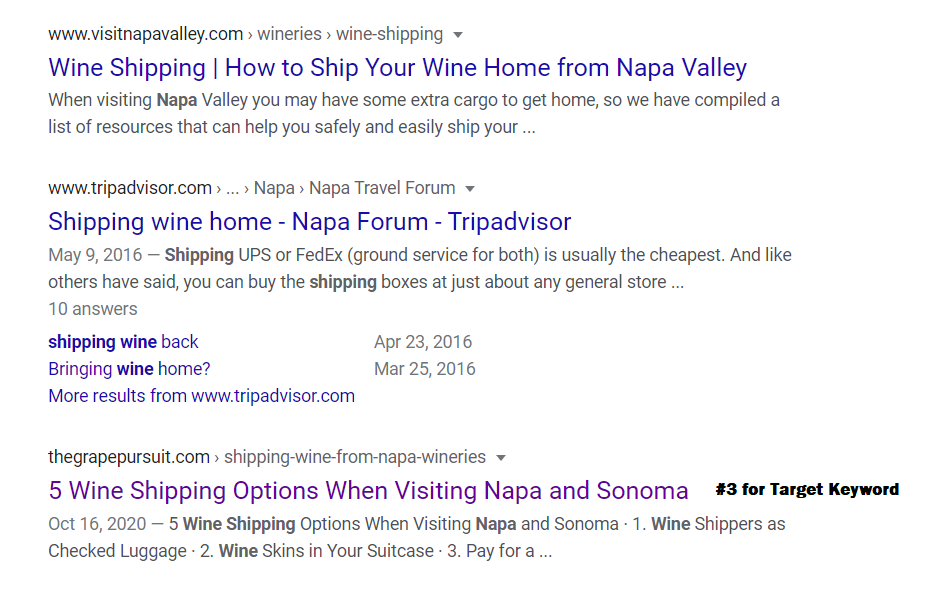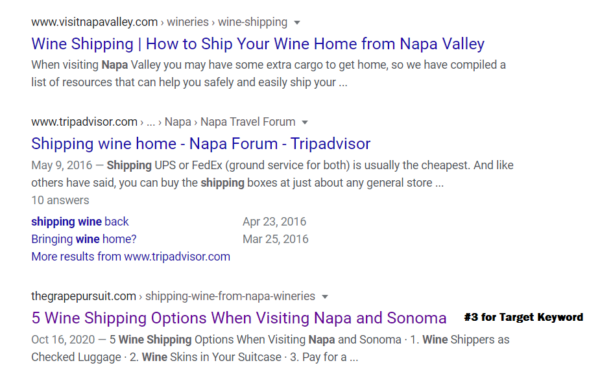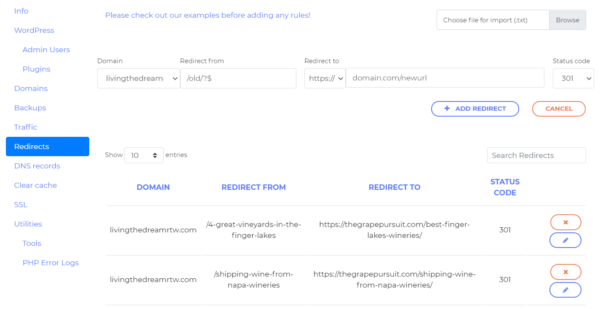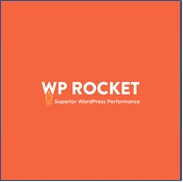Published by Jeremy. Last Updated on January 16, 2021.
Disclaimer: This Week in Blogging uses demographic data, email opt-ins, and affiliate links to operate this site. Please review our Terms and Conditions and Privacy Policy.
Many long-time bloggers are opening focused, niche blogs these days, and some may find that existing content on their first site may be much more relevant for their newer ventures. But if these articles are already receiving traffic on your main site, it certainly brings up a number of possible concerns on the best course of action to pursue.
This certainly happened to us.
On our travel blog, for example, we had many articles about wine tasting around the world (and tangential wine topics as it has always been a hobby of ours). When we started our wine blog, these were a better fit for the story we wanted to tell and we were left with the options of writing a new variant of the articles outright or simply copying them over. The same is true for my blogging advice articles on my travel blog as well. Now that I write here at This Week in Blogging, many of those articles simply make much more sense for them to live here.
Ultimately, the question we're tip-toeing around here is all about branding- specifically whether or not you are more likely to get more clicks on your original domain or on a more niche-specific one (especially in search results). It doesn't take a big leap to understand that my general travel blog called Living the Dream simply doesn't make sense to be home for blogging topics when a site like this one has better branding for it.
I opted to go the route of copying articles over to my new sites outright, and I have to admit I was a bit skeptical about what would happen. I ended up being pleasantly surprised.
Benefits of Moving Articles to a New Blog
Before getting into the technical details of how to do this we should probably touch on the why first. You may be wondering- if you have an article that is ranking on one site, why would you move it to a brand new one and risk upsetting your position and search traffic?
I know that was my first thought.
Everything I know about Google suggests the domain an article is found on is one (admittedly important) factor in how it ranks. Moving an article from a high authority site to one that is brand new did not inspire confidence that they'd somehow retain their rank for competitive keywords- especially when you consider that these new sites hardly ranked for anything at all at the time of this test.
I posed this question in several blogging Facebook groups, and privately with friends who have their own niche sites, and I got a very consistent answer- Google generally treats these articles exactly the same insofar as a 301 redirect exists that forward the old link to the new one. All backlinks, “link juice”, and authority that the link on Site A has will likely be transferred in its entirety to the link at Site B (in theory, at least).
So you will understand my surprise when I moved articles over with 301 redirects and within a few days, Google updated not only to feature the articles as found under the new domain but with the same exact position as well!
This allowed us to instantly add hundreds of page views per month onto these new sites, but also get them a slew of now-forwarded backlinks, and of course, the keyword position that our new domains would've taken years to grow into otherwise.
We did this all with 301 redirects and a few simple steps when moving our articles over.
A 301 Redirect is Your Best Bet
301 redirects are a way you can automatically forward traffic from one link to another while preserving backlinks. When the redirect is in place, a user may click a link to your old article (on your first site, via a 3rd party, Google, or wherever), but the redirect sends them to the new one automatically. For example, if you click the first link below, the 301 redirect that is in place should automatically forward you to the second link without you noticing at all:
- https://www.livingthedreamrtw.com/4-great-vinyeards-in-the-finger-lakes
- https://thegrapepursuit.com/best-finger-lakes-wineries/
This helps ensure that there are no broken links anywhere but is also said to help you retain a lot of the SEO value you have built up across the internet as it is effectively transferred to the new link. When Google's crawling robot sees this, it recognizes that the 301 aspect of the redirect is permanent and they (should) update their results with the new link accordingly.
The first step is simply copying your article from Site A to Site B. Apart from a few key edits for relevancy, we retained most of the same title, URL slug, meta description, etc. so it was a fairly clean-cut and paste from one WordPress post screen to another (we copied the HTML under the “Text” view to transfer the true code exactly as published). Once everything matched up, we published the article on the niche site.
Next, for an extra layer of caution, we downloaded the images from the article and re-uploaded them to the new website such that they'd have the new domain's URL extension. Mostly the reason for this was because by copying the HTML over per the above, the images were still served via the old domain. This could be fine for some, but we wanted to scrub the article's connection to the old website just in case we ever clean our server, sell, or do any number of situations that could break the image on accident.
The next step is the crucial one- we added 301 redirects pointing from our old URL (Post A) to our new one (Post B). This can be done in a number of ways either server-side or with a plug-in (Rank Math, Yoast Premium, etc). We generally like to do these server-side because the call-up for the redirect happens sooner than when a plug-in would load it (less slowdown associated) and you are not committed to keeping a plugin to ensure your redirects remain live- if you move hosts the redirects can be easily ported with your site in a few clicks.
How you go about adding a server-level redirect will likely be tied to your host. Ours, BigScoots, has a dashboard in their client portal where we can go in and add redirects automatically. Other hosts may have you email them so they can add it, or do not give you the function at all (at which case you'll have to use a plugin). There is no universal answer that works for everyone on this end, but you will need to research your own setup and how you can add a 301 redirect yourself between the URLs to make this work.
Once this is live, attempt to load the link to the old post and ensure that it automatically transfers you to the new site. After, you may also want to go back into the new articles and ensure you do not have any links to your old domain that may need cleaned up or changed to your new domain. Since we ported over all of our wine content to our new blog, many of these articles interlinked between themselves on the old domain. While they would all be automatically redirected if a user clicks on them, we updated them to the new domain for continuity and clarity all the same (we did not update any remaining links on our older site- just those on the new domain).
Finally, submit both the old and new URLs to Google's Webmaster Tools to get the search engine to crawl them just a bit faster. All you have to do after that is wait, and hopefully within a short period of time the URL will update with your new domain!
- Note: We've had 301 redirects work for articles on both this site and my wine blog. Sometimes our article ranking would disappear for a few days, but ultimately every article we moved returned to their original rankings. As this is based on limited data, we have to admit that your mileage may vary.
You May Want to Unpublish the Original Post
At this point, if everything is done correctly, any time you click the link from the original domain, it should automatically load the article via its new domain. This should happen when clicked via Google, clicking via internal links, and any other instance when the article is loaded via a click.
What we later found out when adding redirects is that even though the link will automatically redirect to your new domain when clicked, the content is still technically published on the original blog. The redirect ensures you do not see it when a link is clicked (which is the vast majority of cases), but it still may appear in select preview areas like on archive pages, in category/tag lists, and even in related post widgets.
If you click the link in any of these instances, it'll redirect to the new domain. But because the article is still technically published on the original site, it filters into these all the same. The programming for these cases simply isn't “smart” enough to tell that your link has been redirected, and will still think the original article is still live (because it technically is).
You may like this or you may not. On one hand, it could give some more opportunities for readers of your original blog to still reach the content on the new blog. On the other hand, it is also weird to click a link that should be on the same domain and then be redirect to a site you've never heard of before. As we fell into the latter camp, we decided to simply unpublish the original post to remove these instances from the first site outright- but this is something that is up to you.
Either way, the 301 redirect will still hold and should route users to the new domain whenever the original URL is clicked.
What About Canonical Tags?
An alternative option that bloggers sometimes like to do is keep the same article live on both sites if they could be relevant to two separate audiences. In this case, you have to approach things differently such that the second article is not penalized for copyright infringement. One such way to go about this is with a rel=canonical tag on the duplicate article that points back to the URL you want to be considered the original, master article.
For example, if we have Posts A and B on two sites. You wish to keep both of these live for your specific situation, but you want Post A to be considered the original in the eyes of search engines. You can then add a canonical tag in Post B pointing back to Post A as the master as follows:
<link rel=”canonical” href=”[link to Post A]” />
This code, found in Post B, is essentially saying that B is a duplicate (as rel=”canonical” appears) and that the link tagged, Post A, is the master. If all goes well, Google will recognize that Post B is a duplicate and you can have them existing on both sites with A being considered the master for display in search results.
Going this route brings up a lot of possible questions that there aren't very good answers to. How much value do backlinks pass between posts? (Probably very little.) Can this help with getting a new blog indexed faster? (Doubtful.) Do all search engines treat these tags equally? (Unclear.) I could go on, and while there are speculations on this end I think this is a much more risky endeavor depending on your intended outcome.
As this article is tailored for those who want to move content over from an existing blog to a new one, odds are good you wouldn't want to have the article exist on both sites. Likely, you're going to be moving an article from a more general site to a more niche-focused one and would want that content to live exclusively on the new site outright. As such, a 301 redirect would make more sense there to help funnel the existing traffic over to a better-targeted site.
But because we cannot comment on all the scenarios out there and, since some people may want to have articles live on both blogs, the canonical tagging system may be something you could look into more as an alternative if your specific situation calls for it. I'd probably shy away from this myself.
Overall, I was surprised by how well porting over articles to a new niche blog worked. I was really worried that my articles would not retain their rank in search, but somehow it seemed like they did without any noticeable change. Can I guarantee this would be the case for everyone? No. I still view this as a risk, but if you are on the fence on whether or not to do it I would err on the side that it is a risk worth taking.
Or, at the very least, a risk worth testing with one or two articles before moving over more!
Have you moved an article from a general blog to a niche blog? How did it go for you? Comment below to share!
Join This Week in Blogging Today
Join This Week in Blogging to receive our newsletter with blogging news, expert tips and advice, product reviews, giveaways, and more. New editions each Tuesday!
Can't wait til Tuesday? Check out our Latest Edition here!
Upgrade Your Blog to Improve Performance
Check out more of our favorite blogging products and services we use to run our sites at the previous link!
How to Build a Better Blog
Looking for advice on how to improve your blog? We've got a number of articles around site optimization, SEO, and more that you may find valuable. Check out some of the following!














GUYS! This is so helpful. I am right in thick of deciding whether this is something I want to do with a few destinations on my travel blog. Fingers crossed I have as much success as you did by moving them over. Thank you!
Best of luck! If you need any advice on this beyond what we have in the article you’re always welcome to shoot us an email.
Hi there
I recently deleted an article on my blog because the article doesn’t match and suits my blog purpose., and I noticed the deleted article still ranks on page 1…..So I coped the article word for word and moved it to another blog that matches that intent.
So i 301 redirected the new article to a new blog word for word.
Will this have a negative effect or is there a need for canonical….
If you have a redirect that points from the old URL to the new one, then that should be enough. It isn’t without risk, but most people find the new URL appears in Google after a few days as a replacement for the old one.
Canonical linking would be more for if you wanted to have the article live on both sites. The canonical link tells Google which is the primary URL it should consider. At least, that is my understanding of canonical links. But if you’re only having one live on the internet, the 301 is enough.
Thanks so much for this article! I’m considering separating my recipe and travel blog into two and had no idea where to even start. This is immensely helpful and adding to my peach of mind.